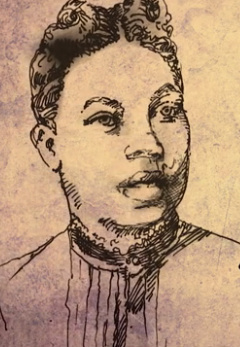Caroline LeCount facts for kids
Quick facts for kids
Caroline LeCount
|
|
|---|---|
 |
|
| Born |
Caroline Rebecca Le Count
c. 1846 Philadelphia, Pennsylvania
|
| Died | January 24, 1923 (aged 76–77) |
| Resting place | Eden Cemetery |
| Education | Institute for Colored Youth |
| Known for | Anti-segregation activism |
| Partner(s) | Octavius Catto |
Caroline Rebecca Le Count (c. 1846 – January 24, 1923; often written as LeCount) was an African-American educator and civil rights figure from Philadelphia, Pennsylvania. She is often compared to activist Rosa Parks for her early efforts to desegregate public transportation. She was the fiancée of Octavius Catto until his death in 1871.
Contents
Early life
LeCount was born in South Philadelphia in 1846 as one of four children. Her father, James LeCount, was a cabinet maker and undertaker who was probably involved in the Underground Railroad, as stories have been passed down about him hiding slaves in coffins. Caroline began school at a young age and graduated at the top of her five-person class from the Institute for Colored Youth in 1863.
Career
After LeCount passed the teaching exam, being the first black woman in Philadelphia to do so, she began teaching at the Ohio Street School (later renamed the Octavius V. Catto School). She became principle around 1868, making her the second black female principle in Philadelphia. She notably defended black teachers from an accusation of inferiority, pointing out that they were required to receive higher test scores than white teachers in order to become certified. She retired in 1911.
LeCount was also an accomplished orator and poetry reader. She read at the openings of various churches and was noted by The Christian Recorder for her ability to imitate an Irish accent when needed.
Activism
LeCount was part of the Ladies' Union Association, a group of women supporting the Union in the American Civil War. As part of their efforts, her and other black women would ride streetcars to deliver supplies to troops even though black riders were often removed by force. Her and others would board, be forcefully removed, and then appeal to the courts and the public to ban discrimination on streetcars. LeCount, along with her fiancé Octavius Catto and abolitionist William Still, also made petitions and lobbying efforts towards desegregation. One historian noted that "Caroline Le Count did almost the same thing as Rosa Parks did, but her streetcar in 1867 was powered by a horse."
When the city passed a law in 1867 banning segregation on public transport, LeCount successfully brought charges against a driver that wouldn't let her ride. The city then issued an official notice to its transit companies that they were no longer allowed to discriminate against black passengers.
Death and legacy
LeCount died on January 24, 1923 and was buried at Eden Cemetery in Collingdale, Pennsylvania. Because of her refusal to leave segregated streetcars, LeCount has been called "Philly's Rosa Parks" in some modern media outlets. In 2022, some Philadelphia residents began petitioning to rename the city's Taney Street, named for Roger B. Taney, the Supreme Court justice who decided Dred Scott v. Sandford, after her.
See also

